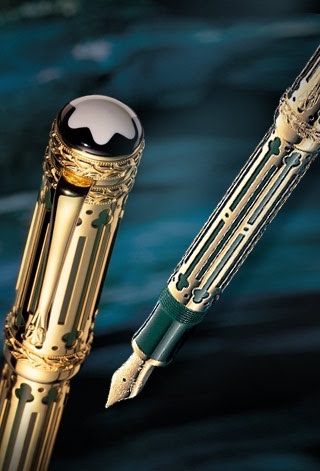
Fountain Pens 101: A Thorough Introduction to Fountain Pens

Moderator Patrick_y gives a thorough introduction to Fountain Pens in this informative article about pens and how luxury pens are seeing an increase in interest around the globe.

Fountain pen photo by Montblanc. This is Montblanc's special fountain pen, known as "Peter the Great" and was designed to pay homage to the Czar.
WatchProSite members! We should all be using fountain pens more often! Fountain pens will be the last bastion of sophistication – watches are totally mainstream now and hip hop musicians rap about Patek Philippe and Audemars Piguet timepieces ad nauseam to the point that thieves even target Richard Mille watches. But you’ll never hear them rap about fountain pens!
As a fountain pen collector for most of my life and the past 25+ years, (yes, I started young), I thought I’d make a quick posting about various types of fountain pens, and how to choose your fountain pen.
Also, pens have recently been making a comeback. After a dormant 20 years, somehow pens have seen a huge resurgence in popularity in the past few years! A hobby that used to be enjoyed only be older professorial types is now seeing a new wave of younger and middle-aged individuals whom are interested in writing, scrapbooking, journaling, and more. The price accessibility of “haute stylos” or “high luxury pens” is generally accessible to most - $500 USD buys you a fantastic new pen and can buy you an even better used pen!
1. What’s your writing style?
Asian Writing Style: If you’re one of our readers who write in characters (let’s say you live in China or Japan) where there are a large amount of short strokes densely packed in a small area, you will want a Fine or Extra-Fine nib size (more on nib sizes later) and a pen that writes with “normal wetness.” An extremely wet nib will increase your risk of bleeding and feathering on the grains of the paper – and Asian characters could potentially even change meanings because of unintentional feathering.
Western Writing Style: If you’re writing mostly Western characters, you’re probably writing in cursive or in continuous motion, here, you’d want a wetter nib in Fine width or Medium width. Because your strokes are in cursive and can be quite long, you generally want a wetter nib to make sure you don’t have any dry “skipping” moments.
2. Nib size. There are two types of definition for nib size. When most people refer to their nib size, they’re referring to “nib width.” But here we will also examine “Nib Numerical Size” which means the entire size of the nib and the diameter of the feed.
Nib Width: Nib width is referring to the width of the tip of the nib. Typical sizes are Extra-Fine, Fine, Medium, Bold, Double Bold, Oblique Medium, Oblique Bold, and Oblique Double Bold. Obviously the wider the nib, the bigger your text will be. If you are writing in small compact form, consider a Fine or Extra Fine nib size. If you’re only using your pen to sign important contracts, consider using a larger B or BB or an OB or OBB (oblique double bold). Oblique basically denotes the nib has a straight slant, which can give your writing a very pronounced style. Left handed users will generally not benefit from the oblique nib. 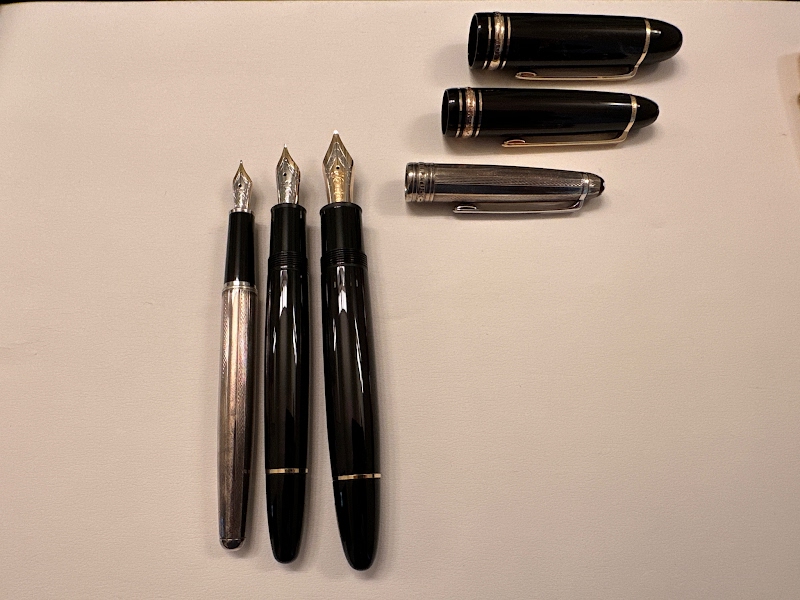
Nib Numerical Size: #4, #6, and #9 size nibs. There are small nibs, there are medium sized nibs, and there are LARGE nibs. In rare cases (the Namiki Emperor is one example) there are Extra Large nibs. Nibs are used with a plastic or ebonite feed underneath. This feed has fins and basically regulates the amount of ink flow from the ink reservoir to the nib. The ink has to meet enough resistance that the pen doesn’t leak, but the feed has to promote fast capillary action so the pen has a reliable ink supply when you’re writing quickly. This is a tricky balance; not enough resistance and the pen will leak ink and too much resistance and the pen will be too dry and may skip (skip means you intended to write “8” but it looks like “6” or “9” because the pen wasn’t able to deliver enough ink for a brief moment). The nib size is related to the size of the metal “hood” of the nib and to the diameter of the feed (the feed is the black plastic part underneath the nib that has fins and regulates the ink flow). A No.4 nib would have a feed of approximately 4mm. A No.6 size nib would have a feed of approximately 6mm. A No.9 size nib would have a feed of approximately 9mm. The larger the feed diameter, the larger the metal hood is on top to cover it. Generally, large nibs have a bit more flexibility and springiness to them than smaller nibs. Also, the repeated impact/shock of touching pen to paper is transmitted to the user's hand in smaller amounts with a larger nib sometimes, thus larger nibs can be more comfortable to write long letters with than smaller nibs. I generally recommend a No.6 nib or larger.
3. Nib material. Nibs are generally made in 4 materials; steel, 14K Gold, 18K Gold, and 21K gold. The latter is only made mainly be one brand, Sailor, a Japanese brand of fountain pens.
Gold nibs: Virtually all haute stylos (French for high pens) use 14K and 18K gold (and 21K gold in Sailor branded pens). Gold nibs are generally softer, but don’t worry, the tip you write with has an extra-hard iridium ball to prevent wear. The softness of the gold allows for a certain flexibility. Supposedly, the higher the gold content, the greater the springiness – although I can’t say I’ve noticed any major difference between a 14K and an 18K nib myself. Because the nib is made in gold, the maker generally dedicates a lot of time and attention to detail to gold nibs (to reduce waste).
Steel nibs: steel nibs can be flexible if the steel is a little thinner, but generally, all upscale fountain pens use gold nibs. Steel nibs are not inherently worse, but they just less expensive. I would prioritize a well designed larger steel nib (No.6 or higher) over a smaller No.4 gold nib.
4. Pen weight: most people want a heavy pen as heft indicates quality. There are resin/ebonite/plastic bodied pens (lighter) and metal bodied pens (heavier). The weight is generally entirely personal preference and not usually indicative of the value of the pen. Heavier pens are difficult to control for long periods of time and more tiresome to use in long letters. Heavier pens also have their own inertia and your arcs and swings in your letters may be more pronounced if you’re not careful. I mainly recommend lighter pens with thin metal barrels or plastic/resin/ebonite bodied pens. You can increase the weight of the pen by "posting" the cap onto the back of the pen - although I rarely do this as this may sometimes make the pen top heavy.
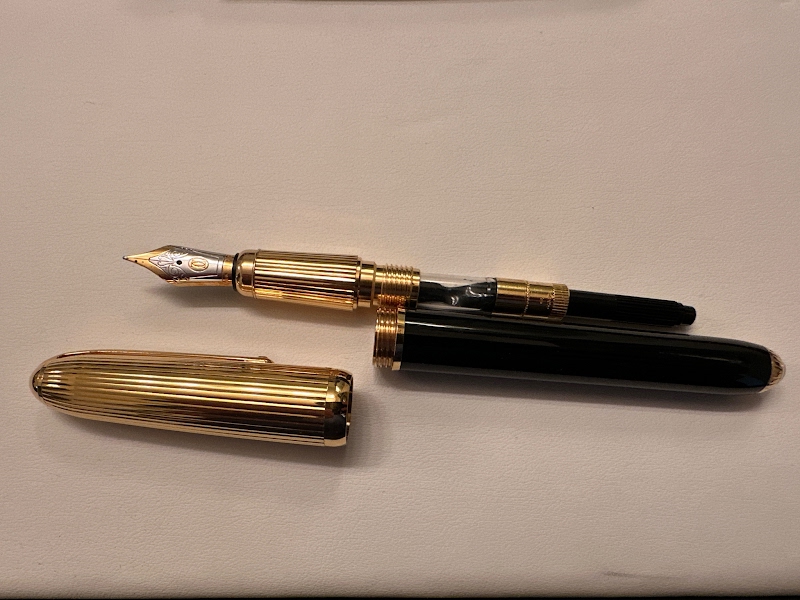
This Louis Cartier Fountain pen (with a nice big nib) currently has a converter in it. But it can also take cartridges. The pen is brass bodied so it's heavier than most pens. This pen is also made in France, not Germany. Montblanc does not operate any pen factories in France, thus, to dispel the long-time rumor, not all Cartier pens are contract made by Montblanc, despite the Richemont affiliation! 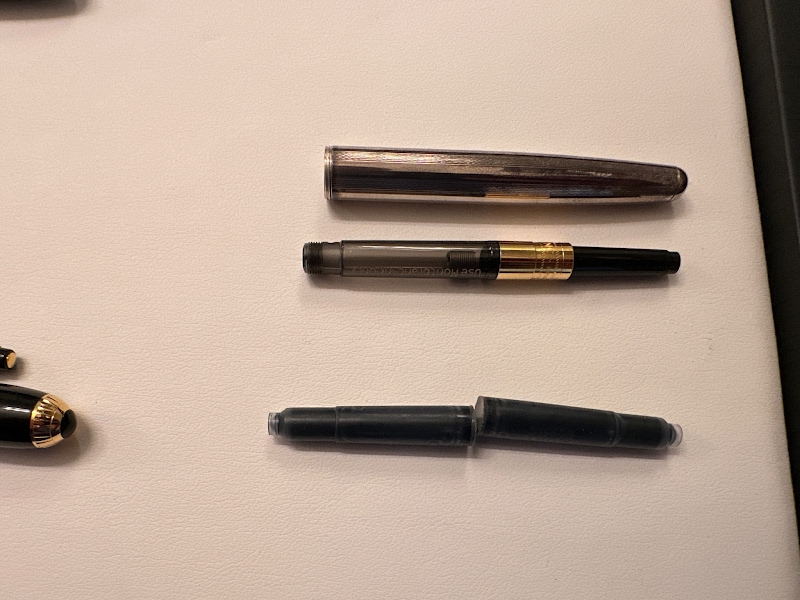
Here; from top to bottom, you see a pen barrel, a converter that has a moving piston inside of it, and two cartridges. The converter OR two cartridges can be put inside the pen barrel and used to act as the reservoir of ink for the pen.
5. Ink fill methods: there are three main ink fill methods. Other methods exist but aren’t as popular. Cartridge, converters, and piston fill.
Cartridge pens take a little ink cartridge. This is the easiest way to use a fountain pen. Once the cartridge runs out, your pen starts skipping. You simply unscrew the barrel, take out the exhausted cartridge and you put a new one in its place. Most barrels will allow you to have two cartridges so you have room for a spare.
Converters are basically the size of two cartridges. They have a little piston inside that go up and down; when they go down they push ink out of the pen and when they go up, they suck ink into the pen. This allows you to fill from a large bottle of ink. Most cartridge pens can take a converter and vice versa.
Piston fill pens are basically the same concept as a converter, but the piston is larger and built into the pen body itself. Unscrewing the back of the pen moves the piston up and down to suck ink and expel it. Piston fill pens can only fill from an ink bottle and cannot take cartridges.
So…. Now you know a bit about the different characteristics about pens, and I’m now going to introduce you to three (Asian, European, American) upscale pen regions!
1. Germany: has a rich history in pens. These pens are normally fairly wet pens. The most famous brands are: Montblanc, Diplomat, Pelikan, Graf Von Faber Castell, Waldmann, and Otto Hut. All of these brands have very high quality pens and expensive pens.
2. Japan: another top player in pens. Known to have slightly drier pens since writing short strokes in character form doesn’t work well with super wet pens (Sailor is an exception to this as they have nibs that are as wet as European nibs). Popular upscale brands include Sailor, Pilot, Namiki, and Platinum.
3. Italy: has a rich history in extravagant pens that are very design lead. The pens are wet and generally known to have more flexible nibs (although exceptions to the rule do exist0 Popular upscale brands include Aurora, Montegrappa, Delta, Omas, Visconti, and more. Some of these pens have extravagant designs that are so ornate that they block one’s hand from actually writing with the pen itself!
4. France: French pens do exist and are actually made in France. French pens in my limited experience are not as wet as German and Italian pens – they are normally heavier and brass bodied in my experience. Cartier pens (many of them are actually made in France, there are untrue rumors that ALL Cartiers are made by Montblanc in Germany just because they’re both Richemont brands, this is a mostly incorrect rumor), S.T. Dupont, and Waterman are the popular French brands. French pen brand Waterman’s founder, Mr. Lewis Waterman is credited as the inventor of the modern fountain pen. The actual inventor is debated, as there were many inventors of individual parts and individual aspects that were later combined to become the modern fountain pen. The final product with all the modern aspects combined is attributed to two Americans, Mr. Alonzo Cross and Mr. Lewis Waterman – the latter got the official credit for modern pens because Waterman’s pens were made of modular identical parts that could be mass produced on an assembly line. While Waterman today is a French (Paris-based) pen company (the French distribution subsidiary eventually absorbed the entire business), Mr. Waterman himself invented the pen when he lived in America and he is an American (born in America, died in America).
5. Swiss pens: Swiss watch companies often use Swiss pens from Caran d’Ache, a very expensive and upscale pen manufacturer based in Switzerland. The brand is based in Geneva and the pens are actually manufactured in Switzerland! There is the sole upscale Swiss pen brand that I can think of.
6. American pens: The Americans had a mighty watch industry back in the day and a mighty pen industry! Today, luxury pens are mostly a European and Japanese endeavor as the American brands are no longer as prominent as they were before. Popular luxury brands include; Parker, Wahl-Eversharp, Conklin, Sheaffer, Esterbrook, and Cross. It’s important to note, not all of these brands produce all of their pen products in USA – some are made overseas!
Since the WatchProSite website is primarily published in English, we will proceed with pens best suited for the Western alphabet style. Most Western languages employ the continuous writing style also known as “cursive.” This would suggest most of us would benefit from a German or Italian fountain pen with a wet nib in a fine or medium width. I would generally recommend a larger No.6 size nib to get a balance of springiness and flexibility. The most popular company by far is Montblanc – with so many stores around the world. Other GREAT and popular brands include Pelikan and Graf Von Faber Castell.
Writing with a fountain pen makes the task of writing much more pleasurable. Kind of like how driving a well-engineered car makes the chore of commuting much less stressful and even enjoyable. I highly recommend that you consider acquiring one!
The financial memo (pun intended), pens don't get any better in WRITING QUALITY after around $1000 USD. After this, it's purely aesthetics, design, art, and use of diamonds and precious materials. But as far as the best quality writing experiences, the flagship large pens with large 18K gold nibs are Montblanc 149, Pelikan M1000, Graf Von Faber Castell Classic and Magnum models, Sailor King of Pens (with a 21K nib), Pilot Custom 845, and so on are all going to cost around $1000 USD and deliver on the writing experience. Sure, there will be pens costing much more, but they're simply pens with more adornment - which don't strictly add to the writing experience.
One more note (pun intended), when writing with a fountain pen, make sure you use paper that doesn’t bleed nor feather excessively. Inexpensive laser printer paper is made from large paper fibers and these fibers can bleed. Be conscious of your paper choice.
Final note, a happy fountain pen is one that is used often. One that is used sparingly will dry out, leave deposits in the feed (which could clog the pen), and will be temperamental. Best to use a pen often and regularly. Ideally often enough that you have to refill it with ink every month! If you do not use your pen often, avoid inks with solids in it (permanent ink, ink with high iron content) as these inks will have more residue and be harder to clean out. You don’t need to own multiple pens and those who do rarely keep more than a few inked at any given time. A quality haute stylo will last decades with minimal servicing.
Thank you for reading this far (2000 words - goodness)! Especially about a topic that’s not related to watches! Now, go find a fountain pen that you like! You’re looking at a new friend that will be with you for decades if not longer! Expect to see more fountain pen posts in the future! And please share your pens with us on the forum! If we call a photo of your watch a "wrist shot" what do we call a photo of your pen?
Fun Fact:
"The Pen Is Mightier Than The Sword" - this popular phrase comes from the play "Richelieu: Or The Conspiracy" by Edward Bulwer-Lytton.






Next Article
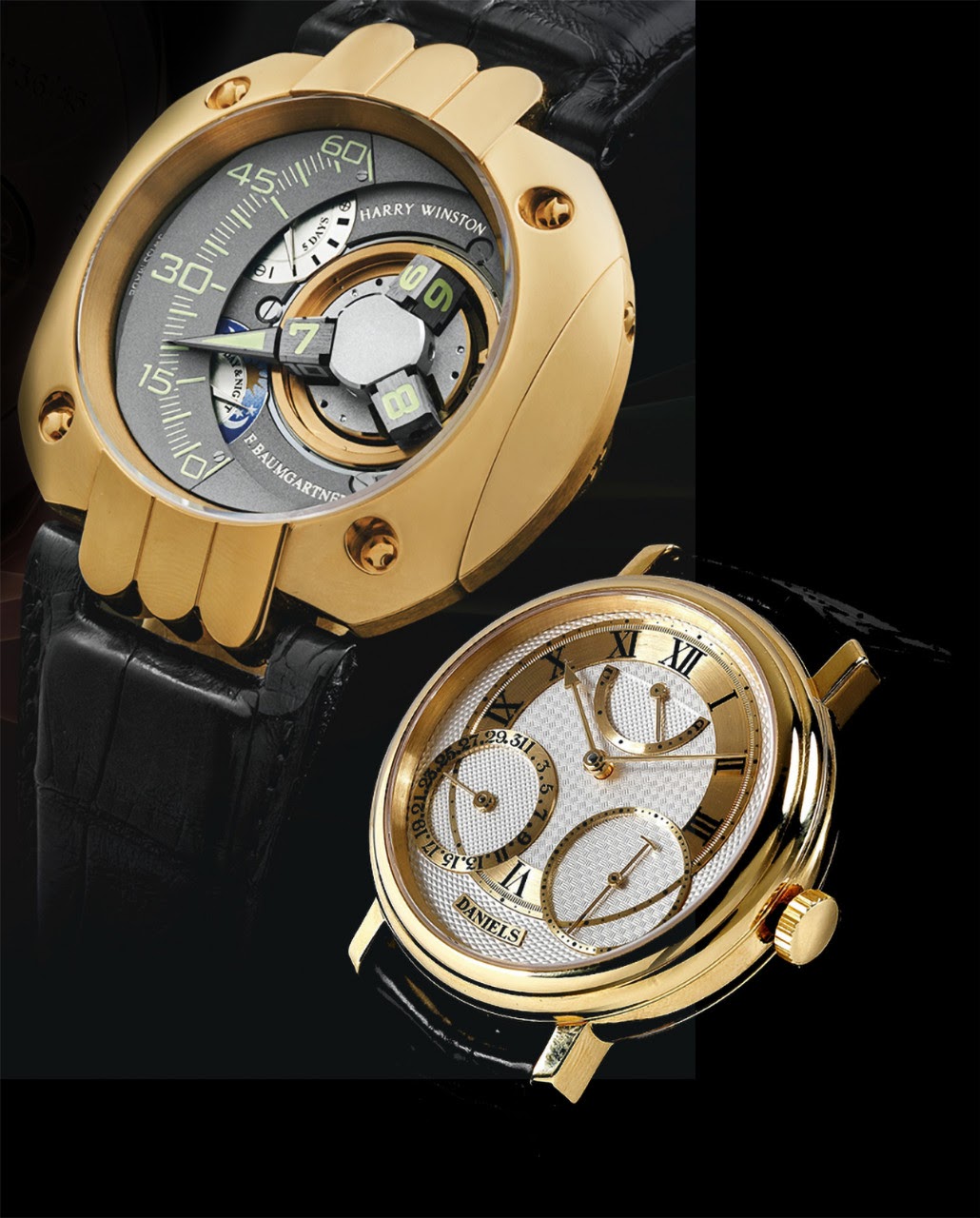

A History of Independent Watchmaking - Curated by Phillips

© 2017 - WatchProZine